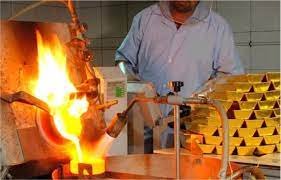Filer and Assembler
OR: INFORMATION TECHNOLOGY- INFORMATION TECHNOLOGY ENABLED SERVICES (ITITES)ces Helpdesk Attendant
SECTOR: GEMS & JEWELLERY
SUB-SECTOR: Cast and Diamond-Set Jewellery
OCCUPATION: Filing and Assembling
REFERENCE ID: G&J/Q2901
ALIGNED TO: NCO-2004/ NIL
Filer: Filer is an important job role in the post-casting process of jewellery
making in cast and diamonds-set jewellery segment.
Brief Job Description: The indivdual works with numerous hand and machine
tools to remove sprues from the cast jewellery piece; rectify casting defects
such as porosity, blisters, bubbles, and cracks; and assemble the final
jewellery components meant for linking.
Personal Attributes: The job requires the individual to have: attention to
details; good eyesight; steady hands; nimble fingers in order to assemble very
small objects; and ability to work in a process driven team for long hours in
sitting position. The individual is expected to have integrity in dealing with
precious materials such as gold and diamonds and/or gemstones.
File and assemble cast jewellery piece
G&J/N2901
Unit Title
(Task) File and assemble the cast jewellery piece
Description This OS unit is about removing sprues and extra metal from the cast jewellery piece
and assembling final components of jewellery using hand tools and machines
Scope This unit/task covers the following:
Receive the cast jewellery from supervisor:
read the job sheet to understand design requirements
inspect the jewellery piece for any casting defects that are not repairable and
report it to supervisor
Clean the cast jewellery pieces:
cut the cast tree with sprue cutter or a pliers
finish the casting stub on a cast piece by roll filing or manual filing
rectify all casting defects such as porosity, blisters, bubbles, cracks, etc. , by
soldering and hammering
finish the pieces with file or emery paper or rubber wheel or using tumbling
process such as barrel burnishing, centrifugal barrel tumbling, and spindle finishing
file grooved, contoured, and irregular surfaces of jewellery piece to conform to
design specifications
Check and rectify the size of jewellery pieces:
measure the size of jewellery pieces such as ring size, bracelet length, bangles
diameter, etc.
match sizes with the job sheet
check and rectify the dimensions of the ring using ring stick and bangle using
bangle stick
Assemble different components of jewellery piece:
link components as per the design specifications
solder different components of jewellery pieces including findings
finish soldered areas/points for smooth surface
Control precious metal and diamond and stones loss:
tally jewellery pieces as per the job sheet issued by the supervisor
collect precious metal dispersed during the day (dust and fragments) and deposit
with supervisor on a daily basis
collect and deposit loose diamonds and gemstones to supervisor, daily
tally account of jewellery pieces, precious metal, diamond and stones as per the
job sheet and deposit to the supervisor
wash hands at the specified wash basin as per the company’s policy
Send jewellery pieces for quality check:
rework as per qc remarks on the defective jewellery pieces
return reworked jewellery piece to supervisor
File and assemble cast jewellery piece
Performance Criteria(PC) w.r.t. the Scope
Element Performance Criteria
Filing and assembling To be competent, the user/individual on the job must be able to:
PC1. remove sprues and extra metal to achieve finish as per design requirement
with minimum precious metal, diamond and stone loss
PC2. link components of different product types as per design requirement and
utility of the product
PC3. assemble different parts of jewellery piece with required flexibility and
durability
Controlling defects To be competent, the user/individual on the job must be able to:
PC4. repair the casting defects in the jewellery pieces as per the QC policy of the
company
Productivity To be competent, the user/individual on the job must be able to:
PC5. deliver product in time to the next stage in the process flow
PC6. file and assemble number of jewellery pieces as per target deliverable and
quality approved by the supervisor
Quality of output To be competent, the user/individual on the job must be able to:
PC7. appropriately finish surfaces required as per QC policy
PC8. achieve minimum precious metal and stone loss after filing
PC9. achieve maximum number of quality control approved jewellery piece
Knowledge and Understanding (K)
A. Organizational
Context
The user/individual on the job needs to know and understand:
KA1. company’s policies on: acceptable limits of gold loss, incentives, quality and
delivery standards, safety and hazards, integrity and ipr personnel
management and dress code
KA2. work flow involved in jewellery manufacturing process of the company
KA3. importance of the individual’s role in the workflow
KA4. reporting structure
B. Technical
Knowledge
The user/individual on the job needs to know and understand:
KB1. different types of abrasives for filing
KB2. different types of casting defects such as porosity, blisters, bubbles, cracks,
etc.
KB3. various jewellery grinding, filing and assembling processes
KB4. quality standards required
KB5. uses of different types of tools for different end results
KB6. potential work hazards, particularly, when using soldering torch, tumbler
hand and machine tools
File and assemble cast jewellery piece
A. Core Skills/
Generic Skills
Basic reading and writing skills
The user/ individual on the job needs to know and understand how to:
SA1. to read notes and job sheet
SA2. read company rules and compliance documents required to complete the
work
Sizing skills
The user/individual on the job needs to know and understand how to:
SA3. measure the ring and bangle size as per the standard ring/bangle sticks used
in different parts of the world defined in the job sheet
Teamwork
The user/individual on the job needs to know and understand how to:
SA4. share work load as required
SA5. accept and interpret the design instructions and requirements correctly
B. Professional Skills Reading design
The user/individual on the job needs to know and understand how to:
SB1. interpret the design as per specifications and relate to instructions given by
supervisor
Use of tools and machines
The user/individual on the job needs to know and understand how to:
SB2. identify tools, equipment and procedures required for removing the sprues
and extra metal from the castings
SB3. use following key tools, machines and consumables for filing and assembling:
files – mill files, hand files, joint round edge, half round, knife files, pippin
files, square, diamond files, needle files, etc.
file handles and cleaning tools
emery paper for finishing
rotating grinders
rubber wheel
tumbling machine such as barrel burnishing, centrifugal barrel tumbling,
spindle finishing, etc.
ring and bangle sticks
soldering torch
hammers and mallets, saws, pliers and cutters
clamps and vises
fuel (natural gas, propane, acetylene) with air/oxygen
saw frames and saw blades
flex shaft motorized handpiece
work holders
hand pieces
flex shaft
gauges
File and assemble cast jewellery piece
magnifiers
high speed motor
SB4. operate, maintain, sharpen and repair tools
SB5. work in a safe environment, i.e., without injuries
SB6. organise tools and documents required for the job
Assembling technique
The user/individual on the job needs to know and understand how to:
SB7. achieve correct level of soldering in order to join the different components of
jewellery piece
SB8. ensure linking for different product types as per design requirement and
utility of the product
Reflective thinking
The user/individual on the job needs to know and understand how to:
SB9. plan the grinding and filing process in such a way that improves surface finish
and reduces gold losses
SB10. use correct posture while performing the job of the filing and assembling
SB11. reduce precious metal loss
SB12. place the tools on the working bench for effective work management
SB13. improve productivity and increase efficiency based on past working
experience
Critical thinking
The user/individual on the job needs to know and understand how to:
SB14. use logic and reasoning to identify the probable solutions for correcting
defects of cast jewellery pieces
Respect and maintain IPR
Unit Code G&J/N9901
Unit Title
(Task) Maintain IPR of company and respect IPR of other companies
Description This OS unit is about protecting company’s IPR and avoiding infringement to IPR of
other companies
Scope This unit/task covers the following:
Protect company’s Intellectual Property Rights (IPR)
prevent leak of new designs to competitors by reporting on time
be aware of any of company’s product or design patents
report ipr violations observed in the market, to supervisor or company heads
Avoid infringement to IPR of other companies
read copyright clause of the material published on the internet and any other
printed material
consult supervisor or senior management when in doubt about using publicly
available information
report any infringement observed in the company
Performance Criteria(PC) w.r.t. the Scope
Element Performance Criteria
Respecting and
Maintaining IPR
To be competent, the user/individual on the job must:
PC1. be able to spot plagiarism and report
PC2. be aware of patents and IPR
PC3. not be involved in IPR violations
Knowledge and Understanding (K)
A. Organizational
Context
The user/individual on the job needs to know and understand:
KA1. company’s policies on IPR and plagiarism
KA2. reporting structure
KA3. company’s unique product range
B. Technical
Knowledge
The user/individual on the job needs to know and understand:
KB1. patents and IPR laws
KB2. how IPR protection is important for competitiveness of a company
Skills (S) [Optional]
A. Core Skills/
Generic Skills
Communication skills
The user/ individual on the job needs to know and understand how to:
SA1. effectively communicate any observed IPR violations or order leaks
Respect and maintain IPR
G&J/N9901 Respect and maintain IPR
11
B. Professional Skills Decision making
The user/individual on the job needs to know and understand how to:
SA2. report potential sources of violations
Reflective thinking
The user/individual on the job needs to know and understand to:
SA3. learn from past mistakes and report IPR violations on time
Critical thinking
The user/individual on the job needs to know and understand how to:
SA4. spot signs of violations and alert authorities in time
Coordinate with others
G&J /N9902
Unit Title
(Task) Interact with colleagues and seniors
Description This OS unit is about communicating with colleagues and seniors in order to achieve
smooth and hazard-free work flow
Scope This unit/task covers the following:
Interact with supervisor
receive work instructions and raw materials from reporting supervisor
communicate to reporting supervisor about process-flow improvements, product
defects received from previous process, repairs and maintenance of tools and
machinery as required
communicate any potential hazards or expected process disruptions
handover completed work to supervisor
Interact with colleagues within and outside the department
work as a team with colleagues and share work as per their or own work load and
skills
work with colleagues of other departments
communicate an discuss work flow related difficulties in order to find solutions
with mutual agreement
receive feedback from QC and rework in order to complete work on time
Performance Criteria(PC) w.r.t. the Scope
Element Performance Criteria
Interaction with
supervisor
To be competent, the user/individual on the job must be able to:
PC1. understand the work output requirements
PC2. comply with company policy and rule
PC3. deliver quality work on time as required by reporting any anticipated reasons
for delays
Interactions with
colleagues and other
departments
To be competent, the user/individual on the job must be able to:
PC4. put team over individual goals
PC5. be able to resolve conflicts
PC6. learn how to multi-task relevant activities
Knowledge and Understanding (K)
A. Organizational
Context
The user/individual on the job needs to know and understand:
KA1. company’s policies on: preferred language of communication, reporting and
escalation policy, quality delivery standards, and personnel management
KA2. reporting structure
B. Technical
Knowledge
The user/individual on the job needs to know and understand how to:
KB1. communicate effectively
KB2. build team coordination
Coordinate with others
A. Core Skills/
Generic Skills
Communication skills
The individual on the job needs to know and understand how to:
SA1. read and write preferred language of communication as prescribed by the
company
SA2. read job sheets and interpret technical details mentioned in the jobsheet
B. Professional Skills Decision making
The individual on the job needs to know and understand:
SB1. how to spot and communicate potential areas of disruptions to work process
and report the same
SB2. when to report to supervisor and when to deal with a colleague individually,
depending on the type of concern
Reflective thinking
The individual on the job needs to know and understand how to:
SB3. improve work processes by interacting with others and adopting best
practices
Critical thinking
The individual on the job needs know and understand how to:
SB4. spot process disruptions and delays and report and communicate with
solutions
Maintain occupational health and safety
G&J /N9905
Unit Title
(Task) Maintain occupational health and safety
Description This OS unit is about being aware of, communicating and taking steps towards
minimizing potential hazards and dangers of accidents on the job and maintaining
occupational health and safety
Scope This unit/task covers the following:
Understand potential sources of accidents
to avoid accidents related to use of potentially dangerous chemicals, sharp tools,
hazards from machines and such as heating lamps
Use safety gear to avoid accidents
wear safety gear such as goggles, mask, gloves, ear plugs
Actively participate in the health and safety awareness campaigns
attend fire drills organised by the company or industrial zone
learn first aid procedure
be alert about designated assembly area in the event of an emergency
read and understand the evacuation and emergency procedures
Communicate to reporting supervisor about:
process flow improvements that can reduce anticipated or repetitive hazards
mishandling of tools, machines or hazardous materials
electrical problems that could result in accident
Performance Criteria(PC) w.r.t. the Scope
Element Performance Criteria
Communicating
potential accident
points
To be competent, the user/individual on the job must be able to:
PC1. spot and report potential hazards on time
PC2. follow company policy and rules regarding use of hazardous materials
PC3. attend and actively participate in the health and safety campaigns organised
by the company
Using safety gear To be competent, the user/individual on the job must be able to:
PC4. use or wear safety gear as per the rules of the company
Knowledge and Understanding (K)
A. Organizational
Context
The user/individual on the job needs to know and understand:
KA1. company’s policies on: safety and hazards and personnel management
KA2. reporting structure
B. Technical
Knowledge
The user/individual on the job needs to know and understand:
KB1. how different chemicals react and what could be the danger from them
KB2. how to use machines and tools without suffering bodily harm
Communication skills
The individual on the job needs to know and understand how to:
SA1. effectively communicate the danger
Organising skills
The individual on the job needs to know and understand how to:
SA2. keep all the tools in an organised manner so as to avoid accidents
SA3. keep the work environment safe and clean
B. Professional Skills Decision making
The individual on the job needs to know and understand how to:
SB1. report potential sources of danger
SB2. follow prescribed procedure in the event of an accident
SB3. wear appropriate safety gear to avoid an accident
Reflective thinking
The individual on the job needs to know and understand to:
SB4. learn from past mistakes regarding use of hazardous machines or chemicals
Critical thinking
The individual on the job needs to know and understand how to:
SB5. spot dangers
Decision making
The individual on the job needs to know and understand how to:
SB6. report potential sources of danger
SB7. follow prescribed procedure in the event of an accident
SB8. wear appropriate safety gear to avoid an accident
Keywords /Terms Description
Sector Sector is a conglomeration of different business operations having similar
business and interests. It may also be defied as a distinct subset of the
economy whose components share similar characteristics and interests.
Sub-sector Sub-sector is derived from a further breakdown based on the
characteristics and interests of its components.
Occupation Occupation is a set of job roles, which perform similar/ related set of
functions in an industry.
Function Function is an activity necessary for achieving the key purpose of the
sector, occupation, or an area of work, which can be carried out by a
person or a group of persons. Functions are identified through functional
analysis and form the basis of OS.
Sub-function Sub-functions are sub-activities essential to fulfil the achieving the
objectives of the function.
Job role Job role defines a unique set of functions that together form a unique
employment opportunity in an organisation.
Occupational Standards
(OS)
OS specify the standards of performance an individual must achieve
when carrying out a function in the workplace, together with the
knowledge and understanding they need to meet that standard
consistently. Occupational Standards are applicable both in the Indian
and global contexts.
Performance Criteria Performance criteria are statements that together specify the standard of
performance required when carrying out a task.
National Occupational
Standards (OS)
NOS are occupational standards which apply uniquely in the Indian
context.
Qualifications Pack (QP) QP comprises the set of OS, together with the educational, training and
other criteria required to perform a job role. A QP is assigned a unique
qualifications pack code.
Unit Code Unit code is a unique identifier for an Occupational Standard, which is
denoted by an ‘N’
Unit Title Unit title gives a clear overall statement about what the incumbent
should be able to do.
Description Description gives a short summary of the unit content. This would be
helpful to anyone searching on a database to verify that this is the
appropriate OS they are looking for.
Scope Scope is a set of statements specifying the range of variables that an
individual may have to deal with in carrying out the function which have
a critical impact on quality of performance required.
Knowledge and
Understanding
Knowledge and understanding are statements which together specify the
technical, generic, professional and organisational specific knowledge
that an individual needs in order to perform to the required standard.
Organisational Context Organisational context includes the way the organisation is structured
and how it operates, including the extent of operative knowledge
managers have of their relevant areas of responsibility.
Technical Knowledge Technical knowledge is the specific knowledge needed to accomplish
specific designated responsibilities.
Core Skills/ Generic
Skills
Core skills or generic skills are a group of skills that are the key to learning
and working in today’s world. These skills are typically needed in any
work environment in today’s world. These skills are typically needed in
any work environment. In the context of the OS, these include
communication related skills that are applicable to most job roles.
Keywords /Terms Description
IPR Intellectual Property Rights
Mohs Mohs scale of mineral hardness
NOS National Occupational Standard(s)
NSQF National Qualifications Framework
NVEQF National Vocational Education Qualifications Framework
NVQF National Vocational Qualifications Framework
QP Qualifications Pack
CRITERIA FOR ASSESSMENT OF TRAINEES
Job Role Filer & Assembler
Qualification Pack G&J/Q2901
Sector Skill Council Gem & Jewellery
Guidelines for Assessment
- Criteria for assessment for each Qualification Pack will be created by the Sector Skill Council. Each
Performance Criteria (PC) will be assigned marks proportional to its importance in NOS. SSC will also lay
down proportion of marks for Theory and Skills Practical for each PC. - The assessment for the theory part will be based on knowledge bank of questions created by the SSC.
- Individual assessment agencies will create theory question papers for candidates at every
examination/training centre. (as per assessment criteria below) - Individual assessment agencies will create practical tests for skill evaluation for candidates at every
examination/training centre. (as per assessment criteria below) - To pass the Qualification Pack, every candidate should score a minimum of 50% in theory and 70% in
practical to successfully clear the assessment. - In case of successfully passing only certain number of NOS’s, the candidate is eligible to take subsequent
assessment on the balance NOS’s to pass the Qualification Pack.








